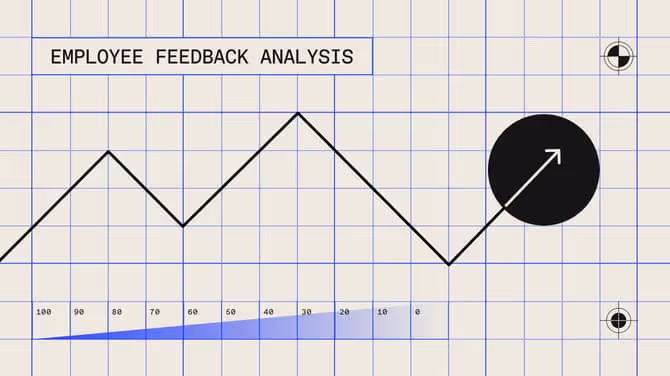10 Benefits of employee engagement, and why it's so important

Discover Workleap Officevibe's benchmark report on 12 key employee engagement metrics

Every manager wants to lead employees who are committed and connected to their work. In other words, they want a team of engaged employees. But why, exactly, is this so important? What are the benefits of employee engagement?
Many things play into employee engagement. Things like how happy employees feel at work, how connected they are with their peers and manager, and how often they feel recognized and appreciated for their contributions are just a few factors of engagement.
When employees are truly engaged, teams go from being good to being great. Challenges turn into opportunities, outcomes turn into achievements, and people give it their all. Let's explore this more closely.
Managers are often told that they need to work on employee engagement. However, the concept of engagement is sometimes hard to understand. We built a list of 10 important benefits to help you understand what employee engagement really looks like.
10 Benefits of employee engagement
The reason employee engagement is so important is simple: it affects all aspects of work. Benefits around engagement impact employees, teams, managers, and the organization as a whole.
1. Better team performance
Employee engagement doesn't just benefit individual employees – it benefits the team. This is because engaged employees perform at a higher level. And when you have a group of engaged employees working together, the team naturally performs at its best as well.
Not only that, but employee morale can be really contagious. When team members are surrounded by driven and motivated peers who care about what they do, they're more likely to feel engaged in their own roles. Individual engagement leads to team engagement, and individual performance improves team performance.
2. Increased employee productivity
Highly engaged employees are more efficient and produce higher-quality work. Why? Because they're personally invested in their job, and their performance matters to them. They're aligned with the team and business goals, and accountable for their individual contribution. This means increased productivity on your team and greater returns for your business.
{emphasize}
Check-in on employee engagement in every one-on-one meeting. If you spot a drop in performance or productivity, it could be an indication of disengagement.
{emphasize}
3. Achieved team objectives
Speaking of hitting targets, employee engagement plays a huge role in your team's success and achievements. As a manager, it's natural to focus your attention on your team's goals. But this doesn't mean you should neglect the employee engagement side as it has a direct, positive impact on your objectives.
It's a two-way street: team members that are aligned on goals feel more engaged, and engaged employees are more motivated to work towards common objectives.
Team members who believe in the vision will help you get there. And they do so because they are engaged in their work and aligned with your business strategy.
4. Less workplace stress
Engaged employees and disengaged employees alike are susceptible to stress at work. The difference lies in how it's managed, as well as the outcomes of that stress. And as a manager, your support will play a huge role here.
For engaged employees, some stress at work is usually much easier to manage and could even become a motivator. Employees who are engaged tend to be more self-aware and can better detect when their stress levels surpass a healthy threshold. They're also more prone to seek support from managers and peers when needed.
On the other hand, when engagement dwindles, stress can become unmanageable and sometimes even detrimental to people's well-being. And this is especially true when employees do not feel a sense of belonging at work and feel unsupported.
Be mindful of when and how you push people. Stress can be a sign that we're on the brink of something amazing! But it can also completely hinder us from reaching those achievements. Make sure your team members know that you have their backs and that stress is only okay if it's propelling them forward.
{emphasize}
💡Not sure how to detect signs of stress? Use our free survey template to help you assess your team's stress levels and uncover the root causes.
{emphasize}
5. Lower risk of burnout
Employee burnout, which the World Health Organization defines as an “occupational phenomenon… resulting from chronic workplace stress that has not been successfully managed,” is one of the biggest issues facing today's workforce.
When employees reach the point of burnout, it has serious consequences – for them, your team, and your organization. Burnout is bad news. But the upside? By keeping your employees engaged with their work and monitoring stress levels on your team, you're helping significantly lower their risk for burnout.
{emphasize}
Burnout symptoms to look out for:
- Mental and physical exhaustion
- Lowered productivity
- Decreased sense of accomplishment
- Decreased job satisfaction
- And – you guessed it: lack of engagement with work
{emphasize}
6. Lower employee absenteeism
Absenteeism has become a big issue in recent years. In the United States alone, nearly one million people skip work each day due to stress. And alarmingly, those who take time off for mental health reasons are seven times more likely to be absent in the future.
When workloads become overwhelming and work-life balance feels unattainable, engagement falls and absenteeism takes a hike. So how can you help as a manager? You can improve employee engagement by fostering a motivating environment that prioritizes health and well-being. You'll see your engaged employees excited to show up for work (online or in person), innovate with ease, achieve goals, and perform at the highest level in no time.
{emphasize}
Reach out to employees when you notice changes in their behavior like taking more sick days or participating less in team meetings. Avoid coming from a place of frustration or judgment, and come from a place of care. Maybe something is going on that you couldn't have spotted otherwise, and you might even be able to help.
{emphasize}
7. ... And lower employee presenteeism as well
As Investopedia clearly puts it, presenteeism is "the lost productivity that occurs when employees are not fully functioning in the workplace because of an illness, injury, or other condition." These days, presenteeism is most often due to mental health issues like stress and anxiety. It traps employees in a negative loop where their challenges contribute to low productivity, and their low productivity causes more anxiety. The catch-22: employees dealing with presenteeism just end up "working" more to compensate.
Unlike absenteeism, the signs of presenteeism aren't stark, so it often goes unnoticed by managers until it becomes a bigger problem. The good news is that measuring employee engagement can help you detect whether your team is struggling and can point you in the right direction to improve your employee's experience at work.
Healthy and engaged employees that feel supported by their managers and peers naturally perform better at work. So, next time feel your team's productivity levels dipping, remember to create a virtuous circle of employee engagement.
8. Higher employee retention and lower turnover rates
If you want to build a high-performing team, you need your employees to stick around. It's hard for teams to do their best work if employees are constantly cycling in and out. When long-standing employees leave, they take valuable knowledge and expertise with them. Plus, training new hires is a significant investment of time, energy, and resources.
An engaged, satisfied employee who's committed to their objectives is less likely to leave. So by improving employee retention rates, you'll have more engaged employees that make your team stronger, more experienced, and better equipped to hit targets.
{emphasize}
Conduct stay interviews regularly. Unlike exit interviews, stay interviews help you spot a disengaged employee before a valuable team member leaves. Every three months, ask your employees what's keeping them at the company and what they enjoy about their work.
{emphasize}
9. Strong ambassadorship and employer brand
A great employer brand is key to business success and it starts with high employee engagement. An engaged employee is more likely to vouch for their organization, and this ambassadorship is worth more than gold in today's labor market.
In fact, highly engaged organizations are usually raved about externally on job search platforms like Glassdoor and through word-of-mouth. So if you're looking to be on everyone's list of dream workplaces, you'll want to make sure your ambassadors are satisfied and motivated at all times. Employee engagement surveys are a great tool to keep these metrics in check.
{emphasize}
📏 Measure employee engagement by calculating your employee Net Promoter Score. This metric will paint a clear picture of your team's ambassadorship levels and their likeliness to promote your organization as a great place to work.
{emphasize}
10. Easier recruitment
It's no surprise that when your employer brand shines, HR's job becomes way easier in the recruitment process. Candidates want to be 100% sure when deciding to join an organization, so they're sure to scour online reviews or their networks for the scoop on what it's like to work at your company.
If your employee engagement is strong, you have nothing to fret about. In fact, your employees are probably doing a lot of the heavy lifting when it comes to attracting top talent simply by speaking highly about their positive experiences at work. And considering that 66% of candidates want to hear more from employees, you'll want to continue involving engaged employees throughout your recruitment.
How to improve employee engagement in your team
Your employee engagement strategy is a part of how you manage your team and doesn't have to add to your workload. Here are some engagement ideas you can try.
Make a healthy work-life balance non-negotiable
No matter how much employees love what they do, if they're overwhelmed or always on, they're going to burn out and disengage. Strong company culture will encourage a healthy work-life balance, which leads to a more engaged workforce. This is especially important on remote or distributed teams, where it's easy for the line between “work” and “home” to blur even more. As a manager, you can make balance the norm on your team.
Set clear, firm expectations and boundaries around work communication, business hours, and taking time off. Openly encourage people to take breaks, book long weekends, and pursue their passions outside of work. Make sure that everyone feels comfortable logging off early if they've completed their work for the day.
{emphasize}
Ask the right questions to learn more about your team's well-being with these employee wellness surveys.
{emphasize}
Measure employee engagement, and talk about it
An employee engagement survey is a great way to collect information on how your people are feeling. Measuring employee engagement helps you spot any issues before they spiral into bigger problems. Officevibe's employee engagement software sends weekly surveys to every member of your team so you can keep a pulse on engagement levels.
Plus, you can collect employee feedback on an ongoing basis. From there, you can plan (and keep track of your notes) directly in the one-on-one software, so engagement is always a talking point.
Help your team set - and achieve - their goals
Your team will be more engaged when they feel like they're making meaningful contributions to collective business objectives.
First, help them understand those objectives. Then you can work together with them to set team goals that are aligned. Finally, set individual goals with team members so they have a clear path forward and something to strive toward.
You can set and track individual goals with each employee using Officevibe, and connect them to team goals in the app. Plus, it's easy to set smaller action items in every one-on-one, and then add it as a talking point for your next meeting so you're sure to follow up. This makes goal progression a part of every discussion, so employees feel supported and empowered.
Employee engagement leads to higher-performing teams
Employee engagement is a crucial part of high-performing teams. Now that you know the benefits of employee engagement, you can put these suggestions into practice – and watch your team thrive as a result.
Want to see where your team stand? Sign up for Officevibe and start measuring your employee engagement today.
Give HR and managers the clarity, confidence, and connection to lead better every day.


%20(1).avif)


.avif)
.avif)








